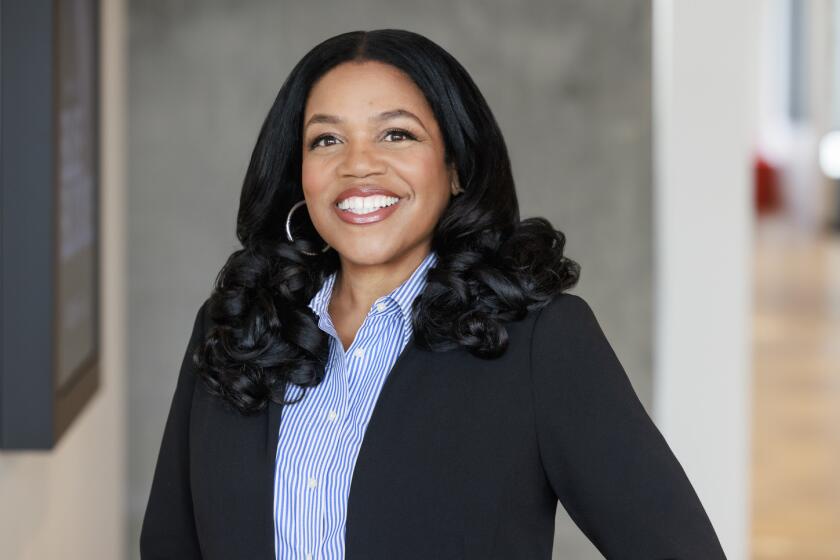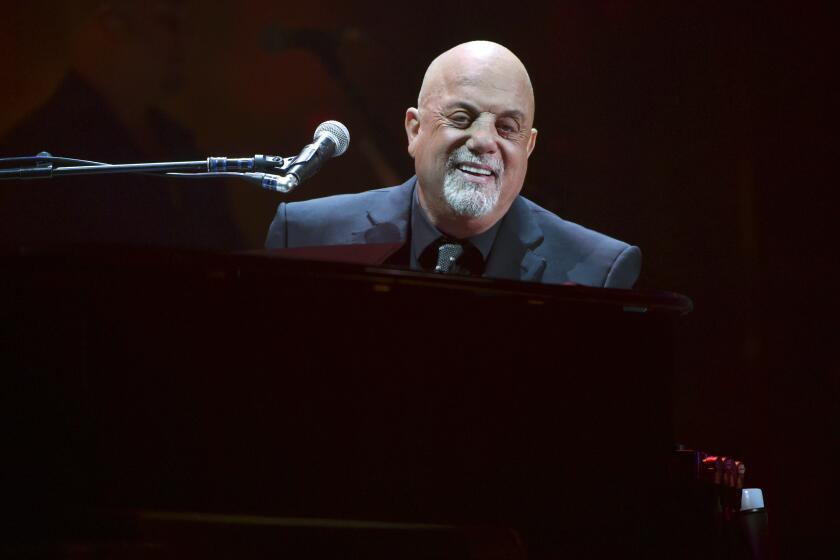What finally broke the ‘no Chicanos’ rule at the reemergent Museum of Latin American Art
On the surface, the new exhibition at the Museum of Latin American Art (MOLAA) in Long Beach doesn’t seem unusual. A series of more than two dozen paintings and mixed-media works by Mexican American artists from around Southern California depict various guises of landscapes — from a tight city grid by José Ramirez to an expressionistic procession of figures painted by the late Carlos Almaraz.
What sets the show apart is that “Somewhere Over El Arco Iris: Chicano Landscapes, 1971-2015” represents the first time in the museum’s nearly two-decade existence that Chicano artists have had an exhibition devoted to their work at the Long Beach institution.
See the most-read stories in Entertainment this hour >>
What took so long?
Until recently, an old museum policy permitted only artists who lived and worked in Latin America to be exhibited.
“It was basically a mandate left over from the founder, Dr. [Robert] Gumbiner,” says Stuart Ashman, who has served as MOLAA’s president and CEO since 2011.
Calls to change what amounted to a “no Chicanos” policy began almost immediately upon Ashman’s arrival.
“The first week I was here,” the MOLAA president recalls, “I went to a reception at the Getty and I was in the elevator with [actor and Chicano art collector] Cheech Marin, whose collection I’d shown when I worked in New Mexico [at the Museum of Fine Art]. He said, ‘When are you going to start showing Chicano art?’
“One of the things that surprised me about [the policy],” Ashman says, “was that it meant that there was no representation of the local community at the museum.”
So last year, he got to work to see if U.S.-born Latino artists could be included within the museum’s mission. “We had some board members who were sympathetic,” Ashman says. “So I worked with the board and with the members of the community to see if we could get [the policy] changed.”
Ashman brought in Armando Duron, a prominent L.A. collector of Chicano art, to make a presentation to the board on the significance of the work.
Duron was persuasive and the rule was changed. Mexican American and other Latino artists living in the U.S. may now have their works regularly shown and acquired by the museum.
“It means a lot to artists,” says L.A. painter Judithe Hernandez, who recently had a pair of canvases acquired by the museum. “It adds gravitas to the resume. It is a very good thing.”
Beyond adding much-needed curatorial flexibility to the museum’s program, the move also has the important side effect of broadening the pool from which the museum might fundraise.
“It amplifies everything,” Ashman says. “We will now have new constituencies. That’s not the only motivation, obviously. But it will be a collateral benefit.”
This comes at a crucial time for MOLAA, which has not been without its share of financial troubles in recent years. When Gumbiner was alive, he had regularly covered the museum’s shortfalls with a well-timed check. But that all ended when he passed away in 2009. And even though he left behind a $25 million endowment, the earnings on that endowment only cover a fraction of the museum’s operating costs. (MOLAA has to raise about 65% of its operating budget every year -- which generally runs in the vicinity of $3.5 million.)
When Ashman landed four years ago, the museum was in the red. In 2012, to get the numbers back in line, he laid off the chief curator and slashed budgets by roughly 15%.
“Gumbiner was great,” Ashman says, “but as a result of his largesse, the museum didn’t develop a community of givers.”
Certainly, the institution is a curious one. For much of its life, MOLAA reflected the very specific tastes of Gumbiner, a healthcare executive who spent decades traveling around Latin America acquiring works — primarily figurative paintings. (His collecting habit began with a purchase of a canvas by indigenist painter Eduardo Kingman during a trip to Ecuador in the 1960s.) He established the museum in 1996 as a place to show his collection and the work of Latin American artists in general.
But his interests, much to the consternation of the Chicano arts community, did not encompass the descendants of Latin Americans who lived and made art in the U.S., despite the fact that their work is often influenced by Latin American history and iconography.
“It was like, ‘Come on, you guys!’” Hernandez says. “This museum is part of the art world and Latino artists don’t have the presence in mainstream institutions that they should ... Not only that, this is a school of art that is highly fueled by the cultural spirit of Latin America.”
Gumbiner passed away six years ago, but the rule about only showing work from Latin America remained firmly in place — until last year when Ashman decided it was time for a fresh start.
This shift runs parallel to changes on the financial side. “By 2013, we were back in the black and in 2014 we were in the black,” Ashman says. “This year [2015] will be the third year that we are finishing the year in the black — not easily or comfortably, but without a deficit.” (IRS 990 forms for 2013, the latest year for which they are available, support this story: The museum had income of $4.2 million for that year, ahead of its operating budget of $3.3 million.)
By including Chicanos in the programming, Ashman hopes that he can activate a greater interest in MOLAA among art aficionados and donors. “It will increase attendance,” he says. “And it should make the museum more accessible within the community.”
But in order to accomplish all of that, MOLAA will also have to improve its curatorial program, which has historically been uneven. The show of Chicano landscapes, organized by outside curator Julian Bermudez, set a cultural milestone, but it is hardly thorough — a mixed bag of works from various private and corporate collections that, quite mystifingly, don’t adequately fill up the gallery space allotted. (Though the show is worth a trip simply to see Frank Romero’s deftly rendered pop-folk canvas “¡Méjico, Mexico!” from 1984, part of Marin’s personal collection.)
A summer exhibition titled “Miradas,” a traveling show drawn entirely from the Bank of America collection, looked at the ways in which various Mexican motifs had manifested themselves in 20th and 21st century Mexican and Mexican American art. An intriguing topic — but the installation at MOLAA felt jumbled, with too many single-file rows of paintings, rather than thoughtful groupings that might allow the viewer to better tease out visual themes and connections.
“Obviously, we are dealing with financial constraints,” Ashman says of the shortcomings. “We do what we can do. We have to live within our means. But we have had a series of exhibits from collections like the Bank of America collection and the FEMSA collection, which have allowed us to have masterworks that would not be accessible otherwise.”
Moreover, Ashman is actively working to improve the museum’s standing within the larger artistic community. MOLAA recently submitted an application for accreditation with the American Alliance of Museums, which, if granted, will make it easier for the museum to secure important loans, among other things.
MOLAA is developing a number of shows that Ashman hopes will capture the eye of museum-goers and critics alike. Next year, the museum will celebrate its 20th anniversary with shows drawn from the permanent collection — which features about 1,400 objects and includes works by 20th century Latin American masters such as Rufino Tamayo, Wifredo Lam and Joaquin Torres García.
In addition, in 2017, the museum plans to launch its first-ever biennial of Latino and Latin American art, drawing from diaspora artists all over the world.
“I want to put Latin American and Latino in a blender,” says Ashman. “I want to see it all together.”
All of this represents an exciting moment for the museum, when the institution is opening itself to the community just beyond its walls.
“Los Angeles is very rich in the arts,” Ashman says. “And it was important for the institution to have a connection to the place where it resided. From a curatorial perspective, I think the contribution of Latino and Chicano artists is essential.”
For the public, it will all translate to a broader view of what is Latin American — and how that fits into the artistic landscape of Los Angeles — a city that, after all, was once located in Mexico.
“Somewhere Over El Arco Iris: Chicano Landscapes, 1971-2015” is on view at the Museum of Latin American Art through Nov. 15. 628 Alamitos Ave., Long Beach, (562) 437-1689, molaa.org.
Find me on Twitter @cmonstah.
More to Read
The biggest entertainment stories
Get our big stories about Hollywood, film, television, music, arts, culture and more right in your inbox as soon as they publish.
You may occasionally receive promotional content from the Los Angeles Times.







